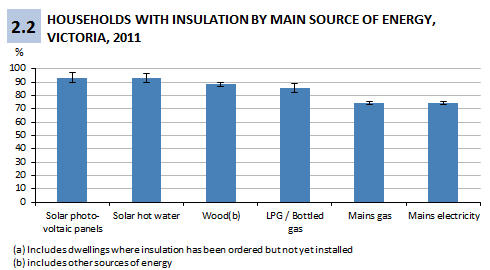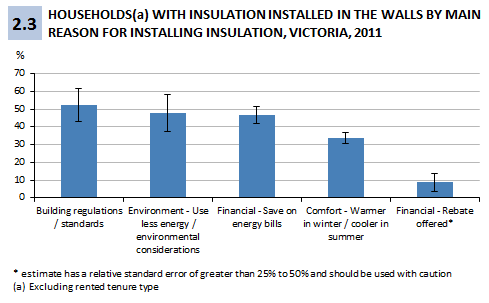|
|
INSULATION
In early 2009 the federal government announced a Home Insulation Program under the Energy Efficient Homes Package as part of the Nation Building Economic Stimulus Plan. Until February 2010, the program gave a rebate to homeowners and renters who installed insulation in their dwellings (ECARC 2010). Similarly, as part of the Victorian Government's Energy Saver Incentive, households may be able to receive a discount for various insulation products (ESC 2012).
This chapter provides information about the household and dwelling types that have insulation and the reasons for installing it.
DWELLINGS WITH INSULATION
Of the 2.2 million households in Victoria, 75% (1.6 million) had insulation (or had insulation on order but not yet installed) and 8% (165,000) did not have insulation. The remaining 18% of households (380,300) did not know if they had insulation or not. In 2009, 72% of Victorian households had insulation, 11% did not, and 17% did not know.
In 2011, households in Balance of Victoria (80%) were more likely than households in Melbourne (73%) to respond they have insulation. One in five (20% or 303,000) households in Melbourne did not know if they had insulation, compared with over one in ten (13% or 77,400) in Balance of Victoria.
In Victoria separate houses (83% or 1.4 million) were significantly more likely to respond they have insulation than dwellings of other types: semi-detached, row or terrace houses, or townhouses (63% or 99,100), or flats units and apartments (37% or 117,600) (Figure 2.1).

Nearly half (47% or 152,900) of all Victorian households in flats, units or apartments did not know if they had insulation, higher than in semi-detached dwellings (28% or 44,500) or separate houses (11% or 182,900).
Victorian households in rented (including rent free) tenure were more likely to respond that they did not know if they had insulation (50% or 265,700), significantly higher than households that were paying off their dwelling (8% or 61,200) or owned their dwelling outright (5% or 38,700).
Nearly all Victorian households using solar photo-voltaic panels (93% or 108,700) or solar hot water (93% or 112,000) as a source of energy had insulation. Most households using wood (88% or 310,800), LPG or bottled gas (86% or 241,400), mains gas (75% or 1.3 million) or main electricity ( 75% or 1.6 million) had insulation (Figure 2.2).

Less than one in five (18%) households with mains gas (324,000) and mains electricity (380,000) did not know if they had insulation, significantly higher than households using LPG/bottled gas (8% or 23,000), wood (5% or 18,200), solar hot water (5%1 or 6,500) and solar photo-voltaic panels (4%1 or 4,400).
WHERE INSULATION IS INSTALLED
Non-renting2 households with insulation were asked where the insulation was installed, or was intended to be installed. Of these, 99% (1.4 million) had insulation in the roof, 34% (474,400) had insulation in the walls and 2% (33,500) had insulation in the floors.
Wall insulation was more common in dwellings that were two years old or less, with approximately two-thirds (63%) having wall insulation compared to approximately one-third (33%) of older dwellings. In 2009, 69% of dwellings aged two years or less and 30% of dwelling aged two years or more had insulation in the walls.
Dwellings in Balance of Victoria (41%) were more likely than dwellings in Melbourne (30%) to have insulation in the walls.
MAIN REASON FOR INSTALLING INSULATION
Households with insulation that were not renting were asked the main reason for installing insulation. Across Victoria, 48% cited comfort as the main reason, followed by building regulations or standards (12%), and saving on energy bills (10%).
Of the households that were not rented in Victoria which had insulation in the walls, over half (52%) responded they installed insulation due to building regulations or standards and 48% responded they could use less energy or had environmental considerations (Figure 2.3). Under half (47%) responded they could save on energy bills and 34% cited comfort considerations.

Footnotes
1. Estimate has a relative standard error of greater than 25% to 50% and should be used with caution
2. Non-renting households includes households that were owned outright, were being paid off, or were of another tenure type including owned but not further defined
References
ECARC (Environment, Communications and the Arts Reference Committee) 2010, Energy Efficient Homes Package (ceiling insulation), Commonwealth of Australia
<http://www.aph.gov.au/binaries/senate/committee/eca_ctte/eehp/report/report.pdf> last viewed 26/6/2012
ESC (Essential Services Commission) 2012, Victorian Energy Efficiency Target, State Government of Victoria, Melbourne
<https://www.veet.vic.gov.au/Public/Public.aspx?id=Home> last viewed on 21/5/2012 |
|
|
 Quality Declaration
Quality Declaration  Print Page
Print Page
 Print All
Print All
 Print Page
Print Page
 Print All
Print All